Student Success Stories
We love to see where the alumni of our program end up and to celebrate their successes. If you have one to share, please let us know.
- Applying 21st-century research to 19th-century tools (audio)
- Gibson Timber Frames
- Historical Carpentry
- The Broad Axe Research Project (2019)
Ciaran Browne, Graduate 2015
I was an International student, I moved from Ireland to Perth specifically to take the program. All that I knew about the course and the college before I arrived was gathered from the college web site, so it was a bit of a gamble on my part to make the move here. Now, looking back at my two years of study, I can honestly say without any hesitation that the course and my experiences at the Perth campus have exceeded to no end, any expectations I could have had.
The facilities for the Heritage Carpentry program are amazing, especially the shop which has both top of the range machinery and hand tools. The library is also an incredible resource for anything carpentry and I still use it frequently. What really made the course for me, however, were the professors. Every teacher that I had during my time there was an expert on the trade. They were always approachable and always made an effort to make the time to help in any way they could, whether it was helping you through a problem if you found an aspect of the course tough, or presenting you with challenges if you were finding certain aspects easy.
Being such a small college I got to form a real and pleasant connection with a lot of the faculty and staff here. The atmosphere at the Perth Campus fostered the best educational experience I have ever had.
Update: Ciaran has continued his work in Heritage Carpentry and Joinery, including being part of the 25th Hour storytelling project as well as operating his own business in Kingston Ontario.
Jeremy Niro, Graduate
Before joining the Heritage Carpentry and Joinery program at Algonquin College Perth Campus I had little experience and knowledge of carpentry. Thanks to the engaging nature of the courses, the tremendous faculty and the comprehensive curriculum I now possess a vast set of varying skills (drafting, woodworking, heavy timber joinery, advanced millwork techniques, etc.). I also gained a comprehensive understanding of heritage architecture and its historical significance. Perhaps most importantly I gained the confidence to put these skills and the knowledge that accompanies them into gratifying employment.
The program itself was fantastic: learning to use and maintain traditional carpentry tools was a great experience and greater is the fact that I now hold the ability to create and shape pieces of work with my own two hands. I had the opportunity to be part of amazing projects such as constructing a timber frame, building a Victorian mantle, carving a church pew, building a segmentally headed door, double-hung windows (which included cutting and glazing panes of glass) and the step by step process of the making a housed stringer staircase. The college is filled with warm and inviting people along with great activities: the mason vs. carpenter tugs of war, the barbecues, weekly hockey games and weekly jam sessions.
By far the best components of the program are the professors. All of them are graduates from the heritage program who have over the years accumulated a wealth of knowledge and hands-on experience which they humbly share with every student. As well as being excellent carpenters, the professors are friendly, approachable and good-humoured people. They take time to listen and answer questions in and outside the classroom. The large and well-equipped woodworking shop, filled with high-quality machines and tools, is truly one of the best perks of the course.
Overall the combination of the theoretical and hands-on learning experiences, along with a comfortable environment and brilliant faculty, made the heritage carpentry experience the best choice I could possibly have made in planning my educational path.
Kim Desroches, Graduate of Carpentry and Millwork – Heritage Program
Before attending Algonquin College, I was a college graduate working in a factory. Following a massive lay-off which affected over 1,200 people, I was a single parent unable to find a position with sufficient income to provide for my daughter and was forced to consider the other alternative – going back to school. Not only was the thought terrifying, but the very idea of going back to school at the same time as my four-year old daughter simply didn’t seem realistic. My options narrowed to this: either work for peanuts or return to school!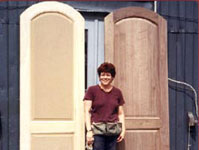
I decided that if I were going to invest in re-education, it would be for an occupation that I enjoyed. I made the plunge and chose the Carpentry and Millwork –Heritage program offered at the Perth Campus. I can honestly say it was one of the best decisions I’ve ever made.
It had been years since I had been in an academic atmosphere and I had no idea where to start. I was a last-minute entry; one day I was unemployed and the next day I was a full-time student. Enrolling at this small campus was a wise choice; everything was on a more personal level. Instructors knew all students by name in very short order. The environment was comfortable, friendly and welcoming.
Peter Ramsay, Graduate of Carpentry and Millwork – Heritage Program, 1994
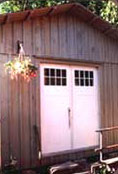
Upon graduating from the Heritage Carpentry and Millwork Program in 1994, I was employed with a restoration contractor based in Kingston for two years. This was an excellent learning opportunity for me since I was entrusted to work independently to dismantle and reconstruct old timber frame and log buildings.
Through the process of deconstruction and reconstruction of old heritage buildings, I was able to explore intimately the inner-workings (and not-workings) of these structures and develop a further understanding of traditional construction techniques.
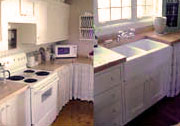 In 1996, I became self-employed and began to take carpentry jobs myself. I started doing small construction jobs where I could explore all aspects of the trade. A small artist’s studio was my first complete building. This job provided me with the opportunity to design and build the structure as well as the windows and doors. I continued to work independently for a few years doing small jobs but always tried to focus on heritage buildings and began to develop a reputation and good working relationships with clients in this niche. Repairing old pine floors, reproducing different types of trim and manufacturing period doors and windows quickly became the mainstay of my business. Small jobs would lead to larger jobs and pretty soon I was expanding the kinds of work to include things such as period kitchens and furniture.
In 1996, I became self-employed and began to take carpentry jobs myself. I started doing small construction jobs where I could explore all aspects of the trade. A small artist’s studio was my first complete building. This job provided me with the opportunity to design and build the structure as well as the windows and doors. I continued to work independently for a few years doing small jobs but always tried to focus on heritage buildings and began to develop a reputation and good working relationships with clients in this niche. Repairing old pine floors, reproducing different types of trim and manufacturing period doors and windows quickly became the mainstay of my business. Small jobs would lead to larger jobs and pretty soon I was expanding the kinds of work to include things such as period kitchens and furniture.
Matthew Bruins, Graduate of Carpentry and Millwork – Heritage Program, 2019
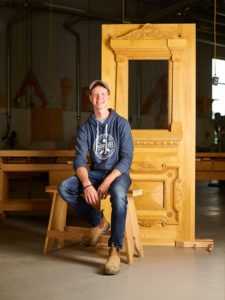
Coming up with the idea for a culminating woodworking project in his final semester at Algonquin College wasn’t easy for Matthew Bruins. “I was set on doing a door, for some reason. I don’t know why,” the recent graduate of the Heritage Carpentry and Joinery Program recalled. “I’ve seen some cool doors and I enjoyed the first door project we did earlier in the semester.”
The college’s two-year program focuses on traditional carpentry and joinery such as timber framing, log building and architectural millwork, as well as restoration and preservation techniques. Instructor Jim Stinson described the final project as one that not only speaks to the students’ interests but also allows them to demonstrate the knowledge and skills acquired through the program’s joinery component. After choosing a piece of existing architectural millwork to explore, the students record and document it, then reproduce it to scale.
“I had a really hard time actually finding this door, in particular,” Matt said. “I was just [searching the Internet for] doors in Ottawa trying to find a … cathedral door or something like that.” One of the images that popped up on Matt’s screen caught his attention. He was captivated by an elaborately-carved door on the Macdonald-Harrington Building at McGill University in Montreal, Quebec. Initially, his instructors were less than enthusiastic about his choice. Jack Hollinger, program coordinator, said their reluctance was no reflection on Matt’s abilities; instead, they were simply concerned about the amount of time required to complete such an elaborately carved reproduction. “It was just nonsense to think that it could be completed within the 72 hours allocated for the project,” Jack said.
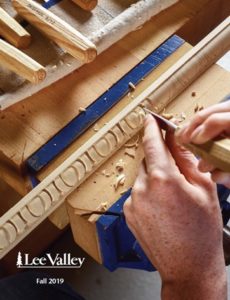 Having been advised against his first choice, the young woodworker from Belleville, Ontario, chose a different door, also located on the McGill campus, and travelled to Montreal to measure it. As fate would have it, he arrived to find that construction blocked access to the door. Having driven all the way to from the college campus in Perth, Ontario, to Montreal (about three hours), he seized the opportunity to measure the Macdonald-Harrington door instead.
Having been advised against his first choice, the young woodworker from Belleville, Ontario, chose a different door, also located on the McGill campus, and travelled to Montreal to measure it. As fate would have it, he arrived to find that construction blocked access to the door. Having driven all the way to from the college campus in Perth, Ontario, to Montreal (about three hours), he seized the opportunity to measure the Macdonald-Harrington door instead.
“I brought a sketch pad and was sketching out dimensions roughly,” he explained. “But it was really cold that day so what I ended up doing was taking my tape measure and phone and just taking videos with my tape measure on different parts of the door so I could go back over them later.” Another challenging aspect was “… getting [the initial design] from my phone measurements into a SketchUp model to scale with the same profiles,” he said. “Since [the door] was in Montreal, I couldn’t go back if I missed measurements, so I had to cleverly scale and find missing measurements…”
Committed to putting in the extra time to reproduce the Macdonald-Harrington door, Matt persevered with his choice. Good-naturedly referred to as “the nonsense door” by Matt and his instructors, the reproduction, made of basswood, is elaborately carved with classical details such as rosettes, dentils, flutes, egg-and-dart molding and other decoration often seen in Victorian-era millwork. He substituted the year 2019 for 1897, the date carved on the original door and the year the Macdonald–Harrington Building was constructed.
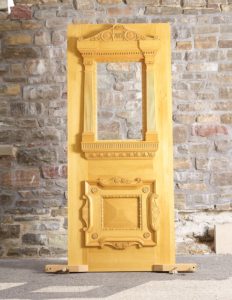 Matt enjoyed both the challenge and the rewards of undertaking the heavily-carved style. “This is my first project ever carving something and I like challenging myself. I didn’t want to be bored partway through,” he said. “I have about 200 hours [invested] in that [door]. Another rewarding thing was seeing the carvings turn out and getting better as I got more practice.” Envisioning the finished product as he worked also helped Matt stay motivated. “That’s how you keep going through some of those monotonous tasks,” he said. “I can really put my head down and work through things if I know the reward is there at the end.”
Matt enjoyed both the challenge and the rewards of undertaking the heavily-carved style. “This is my first project ever carving something and I like challenging myself. I didn’t want to be bored partway through,” he said. “I have about 200 hours [invested] in that [door]. Another rewarding thing was seeing the carvings turn out and getting better as I got more practice.” Envisioning the finished product as he worked also helped Matt stay motivated. “That’s how you keep going through some of those monotonous tasks,” he said. “I can really put my head down and work through things if I know the reward is there at the end.”
Matt credits his college instructors and his parents for encouraging him while he developed his craft. “The teachers here are great; they only want to see the best [in] you. They really go above and beyond to help,” he said. “The same with my parents – helping me get certain tools that are expensive [for me] at a young age, giving me a space to work.”
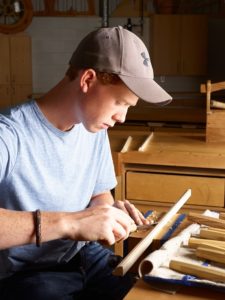 The craftsmanship of other woodworkers inspires him as well. “It’s mostly the older carpenters [who] you don’t know the names of, but you see their work and you just admire that they could do better work than you, with no power tools or [with] less fancy tools,” he says. “The traditional … purely by hand … that is truly impressive.”
The craftsmanship of other woodworkers inspires him as well. “It’s mostly the older carpenters [who] you don’t know the names of, but you see their work and you just admire that they could do better work than you, with no power tools or [with] less fancy tools,” he says. “The traditional … purely by hand … that is truly impressive.”
Looking to the future, Matt can see woodworking as part of his job or career. “If I can get into the really elaborate work, I would love that,” he said. As for his completed project, it will remain at the college for now, but eventually, he hopes to build his own workshop and install the ornately carved front door as a way to display his woodworking skills. Chuckling, he added that he might even attach a tiny sign on the back that proclaims it “The Nonsense Door”.
Source: Lee Valley Newsletter: The Nonsense Door by student Matthew Bruins